Cover crops can increase soil organic matter and fertility, reduce erosion, reduce nutrient leaching and suppress weeds. As a result, they contribute to improving soil health and help ensure the long-term sustainability of cropping systems. These benefits are directly related to production of cover crop biomass. However, in Nebraska there is a short window for cover crop growth between harvest and the planting of the next cash crop. Therefore, early season drill interseeding might be a viable strategy since it extends the window for cover crop establishment and growth.
The use of residual pre-emergence herbicides is an essential weed control tool in corn production because it reduces early season weed emergence, weed-crop competition and yield loss. The residual effect of such herbicides can also reduce, or even prevent, the emergence and establishment of cover crops, emphasizing the importance of choosing an herbicide program that is compatible with early season interseeded cover crops.
To evaluate potential herbicide carryover that could negatively impact cover crop establishment, Bayer and UNL partnered to conduct a study at the Bayer Water Utilization Learning Center near Gothenburg, Nebraska. The goals of the studies were to evaluate cover crop biomass production at (1) different early season interseeding timings in corn and (2) the impact of residual herbicide programs on cover crop establishment.
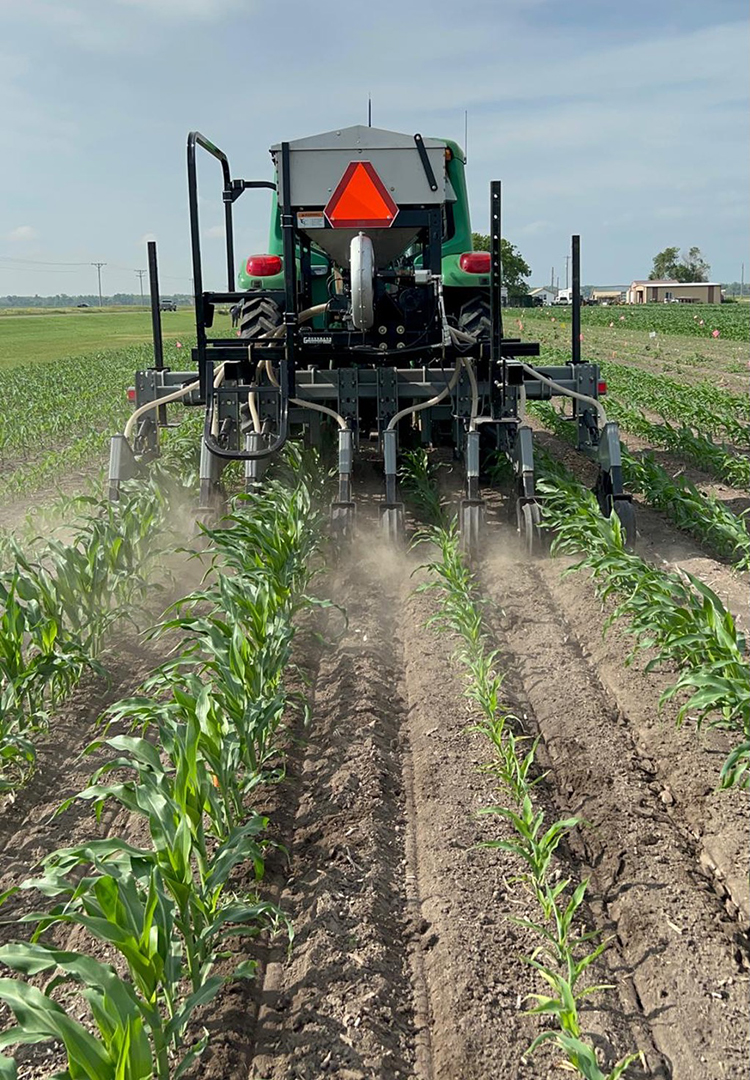
Figure 1. Hiniker interseeder used to interseed cover crops in between corn rows.
Two different studies were conducted. The first study was conducted on standard stature corn, where both interseeding timing and herbicide program (Table 1) were evaluated. The second study was conducted on standard and short stature corn where only the interseeding timing was evaluated. On both studies, a mix of annual rye (10 lb ac-1), cereal rye (35 lb ac-1) and winter wheat (35 lb ac-1) at 80 lb ac-1 was interseeded at V2, V4 and V6 corn stage using a Hiniker drill interseeder (Figure 1). Aboveground biomass of the cover crops on both studies was collected at V10 corn stage and dried to constant weightStandard Stature Corn — Study 1
In this study, all plots received PRE emergence herbicides at corn planting time. Then, all plots were split, and the POST emergence herbicides were sprayed in one split. Thus, we had treatments with PRE only, and treatments with PRE + POST herbicides. The treatments receiving POST emergence herbicides were sprayed after cover crop emergence to assess possible negative impact on cover crops establishment
Table 1. Herbicides and rates sprayed over the study as PRE and POST emergence.
| Trade Name (Active Ingredient) | |
|---|---|
| PRE | POST |
| Verdict® (saflufenacil + dimethenamid-P) at 12 oz/ac + Roundup PowerMAX 3® (glyphosate) at 30 oz/ac | Outlook® (dimethenamid-P) at 8 oz/ac |
| Bicep II Magnum® (s-metolachlor + atrazine) at 67.2 oz/ac + Roundup PowerMAX 3® (glyphosate) at 30 oz/ac | Dual II Magnum® (s-metolachlor) at 1 pt/ac |
| Harness Xtra® (acetochlor + atrazine) at 73.6 oz/ac + Roundup PowerMAX 3® (glyphosate) at 30 oz/ac | Warrant® (acetochlor) at 48 oz/ac |
In this study, the total cover crop biomass production varied depending on the interseeding timing on control plots (no herbicides), as the cover crops were interseeded as the corn growth stage progressed. At V2, V4 and V6 corn stage, total cover crop biomass was 725 lb ac-1, 499.4 lb ac-1 and 334.5 lb ac-1, respectively — shown on Figure 2.
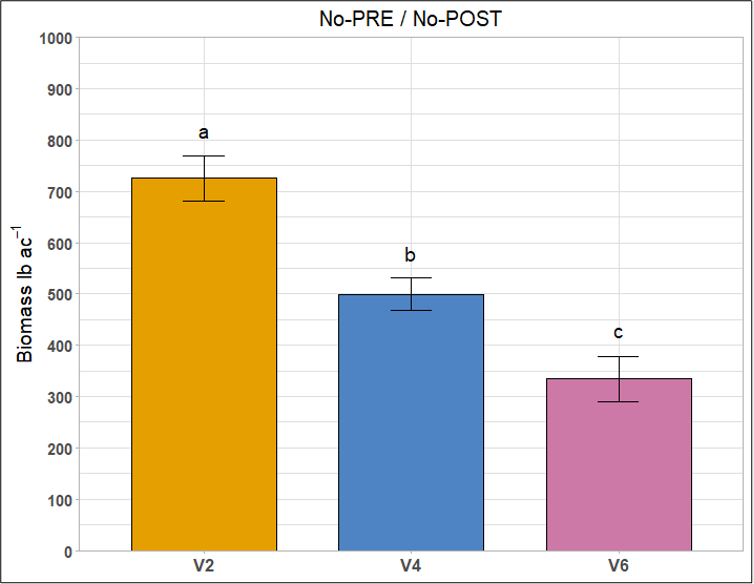
Figure 2. Total cover crop biomass collected from control plots (no-PRE and no-POST) at V10 corn stage of each interseeding timing (V2, V4 and V6). Letters indicate statistical differences (p < 0.05) between treatments within each interseeding timing.
The cover crop mix interseeded at V2 corn stage showed greater cover crop biomass than the treated plots with different active ingredients when no PRE emergence herbicide was applied (Figure 3). Moreover, applying saflufenacil + dimethenamid-P or s-metolachlor + atrazine had similar impact on total cover crop biomass.
At V4 corn stage, No-PRE and s-metolachlor + atrazine treatment had similar cover crop biomass production (Figure 3). However, a grower could safely apply any of the PRE emergence herbicides to control weeds in case of V4 interseeding cover crops decision.
At V6 corn stage, all PRE emergence herbicides had similar impact on cover crop biomass, and aboveground biomass of those PRE emergence herbicide treatments were lower than the No-PRE treatment (Figure 3).
Interseeded cover crops at V2 corn stage did not show negative impact when spraying dimethenamid-P as POST application over plot treated with saflufenacil + dimethenamid-P as PRE, compared with treatments spraying only PRE, as shown on Figure 4. Moreover, spraying acetochlor (POST) after acetochlor + atrazine (PRE) or s-metolachlor + atrazine (PRE) also did not show negative impact on established cover crops. Interseeded cover crops at V4 and V6 did not show negative impact on cover crops by applying POST herbicides after PRE emergence herbicides.
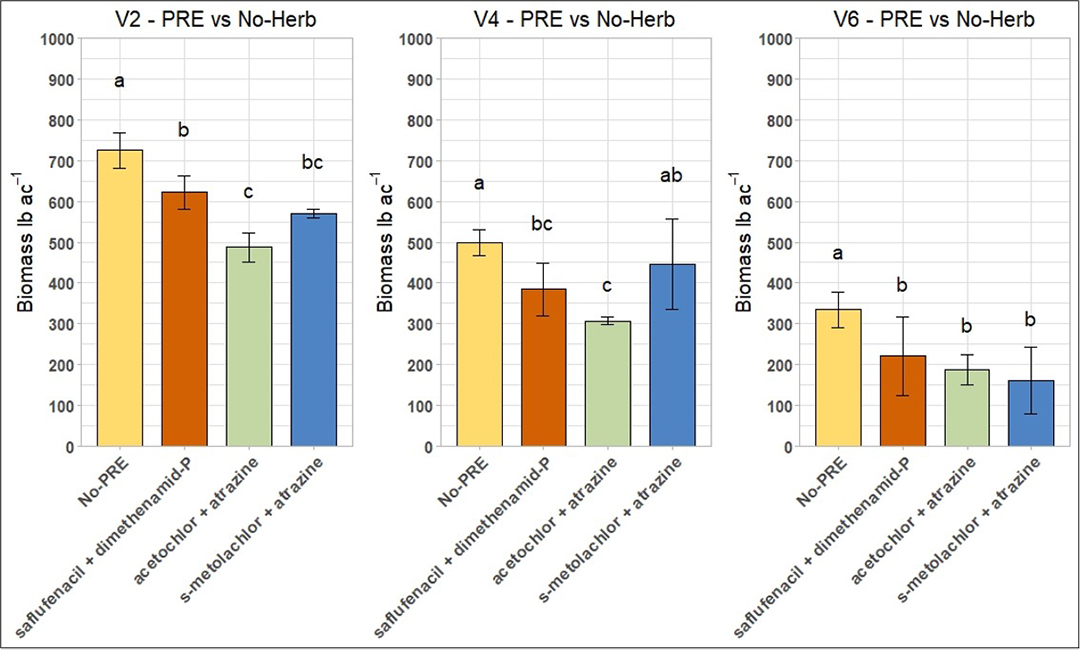
Figure 3. Total cover crop biomass collected at V10 corn stage of each interseeding timing (V2, V4 and V6). Letters indicate statistical differences (p < 0.05) between treatments within each interseeding timing.
Across all treatments and interseeding timings, the biomass production was statistically equal, meaning it is safe to apply PRE+POST herbicides (Figure 4). However, it is important to highlight that the early interseeding at V2 corn stage might result in satisfactory cover crop biomass production.
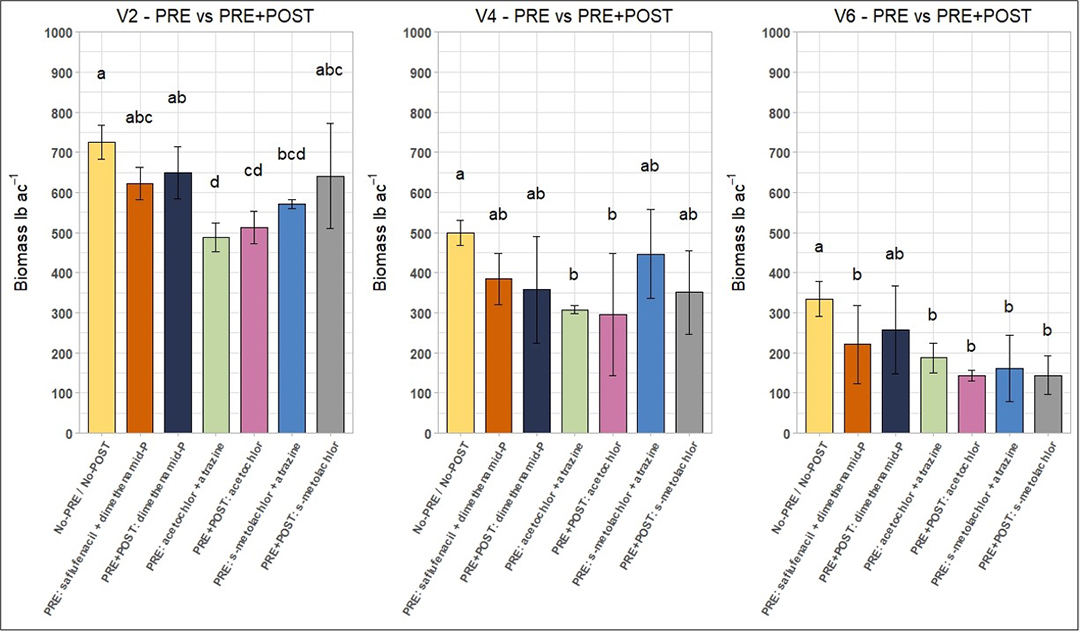
Figure 4. Total cover crop biomass collected at V10 corn stage of each interseeding timing (V2, V4 and V6) and on each treatment (PRE only and PRE + POST). Letters indicate statistical differences (p < 0.05) between treatments within each interseeding timing.
Standard vs Short Stature Corn — Study 2
On this study, all plots received PRE emergence burndown herbicide, DiFlexx® (dicamba) at 8 oz ac-1 and Roundup PowerMAX 3® (glyphosate) at 30 oz ac-1 at corn planting time.
Interseeded cover crops at the V2 corn stage on short stature corn had more biomass production (1075.6 lb ac-1) than the cover crops interseeded on standard stature corn (550.6 lb ac-1), shown on Figure 5. However, interseeding cover crops at V4 corn stage did not have difference between the treatments, with cover crop total biomass of 337.7 lb ac-1 on short stature corn and 367.3 lb ac-1 on standard stature corn. When cover crops were interseeded at V6 corn stage, the short stature corn treatment showed total cover crops biomass production (297.7 lb ac-1) greater than regular stature corn (189.7 lb ac-1), shown on Figure 5.
Interseeding cover crops at V2 corn stage on short stature corn showed to be promising compared to interseeding cover crops in standard stature corn. As corn grows, the canopy for both hybrids start to “close,” blocking the sunlight to reach the cover crops on interrow. Moreover, when planting cover crops at late vegetative corn stage — V4 and V6 — total biomass accumulated are less than the total cover crop biomass observed at V2 corn stage on both short and standard stature corn hybrids. Figures 6 and 7 show the difference of interseeded cover crop stand at V2 corn stage on both standard and short stature corn; pictures were taken late July 2023.
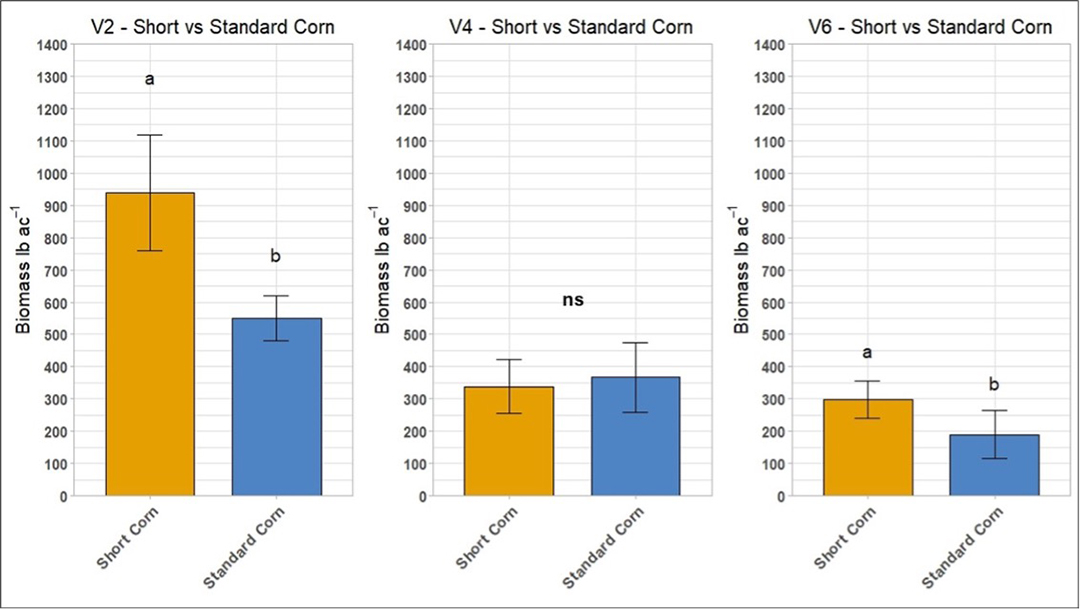
Figure 5. Total cover crop biomass comparison into short and regular stature corn collected at V10 corn stage of each interseeding timing (V2, V4 and V6). Letters indicate statistical differences (p < 0.05) between treatments within each interseeding timing.
Take Home Messages
Growers can safely apply saflufenacil + dimethenamid-P, acetochlor + atrazine, and s-metolachlor + atrazine when interseeding cover crops despite the biomass reduction when compared to no-PRE herbicides (control), as all PRE herbicides did not kill cover crops.
Applying PRE+POST herbicides did not show negative impact on cover crop establishment, compared with applying PRE only.
Interseeding cover crops early on standard stature corn at V2 corn stage showed more biomass production than the late interseeding timings, at V4 and V6 corn stage.
Short stature corn showed potential of satisfactory cover crop biomass production if interseeding occur early, at V2 corn stage, when compared with interseeding on standard corn stature, shown on Figure 5.
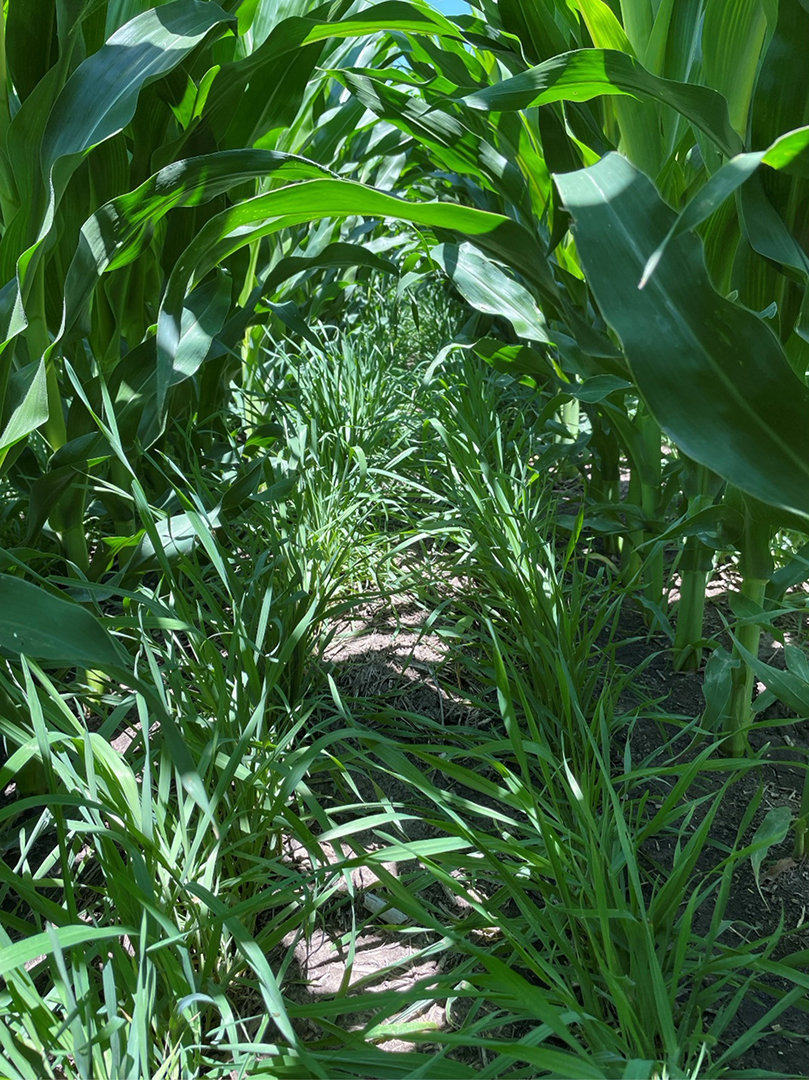
Figure 6. Cover crop stand of V2 interseeding timing on short stature corn. Picture taken in July 2023 at corn stage V10.
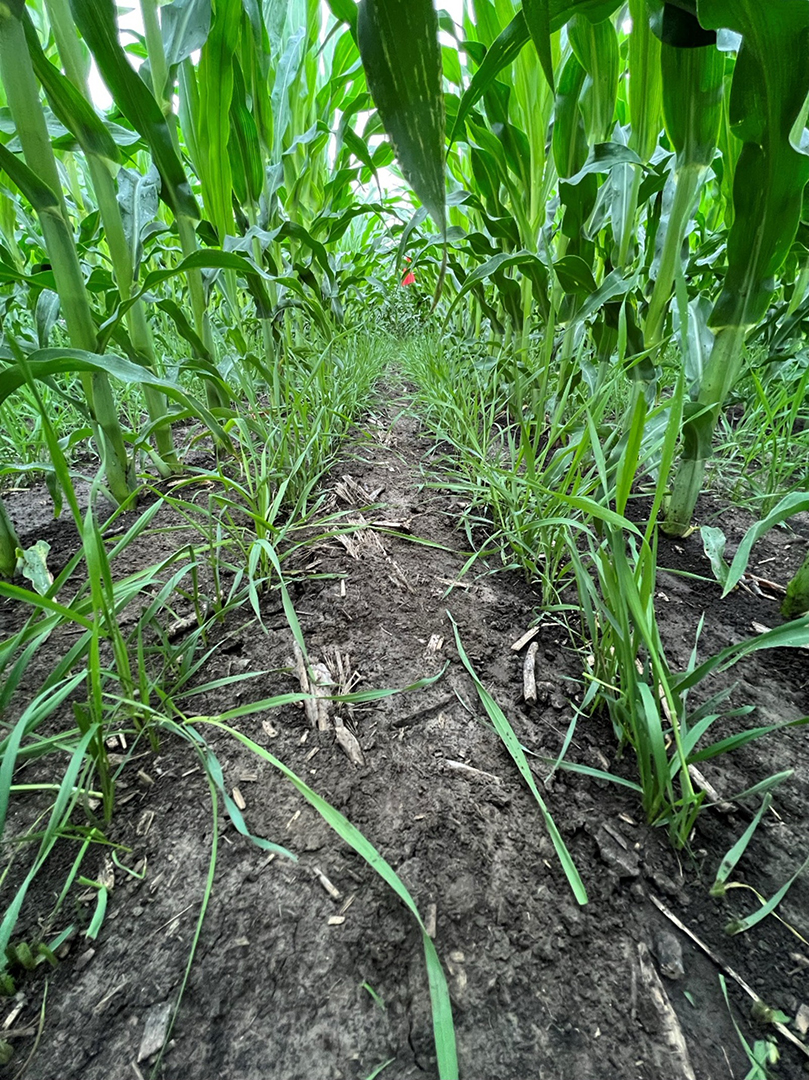
Figure 7. Cover crop stand of V2 interseeding timing on regular stature corn. Picture taken in July 2023 at corn stage V10.





